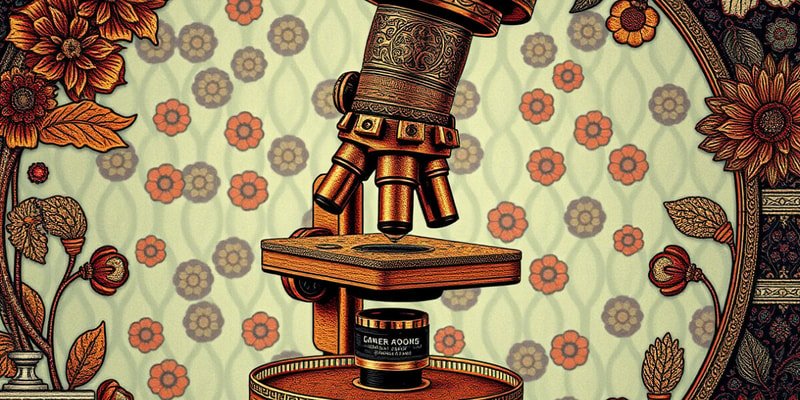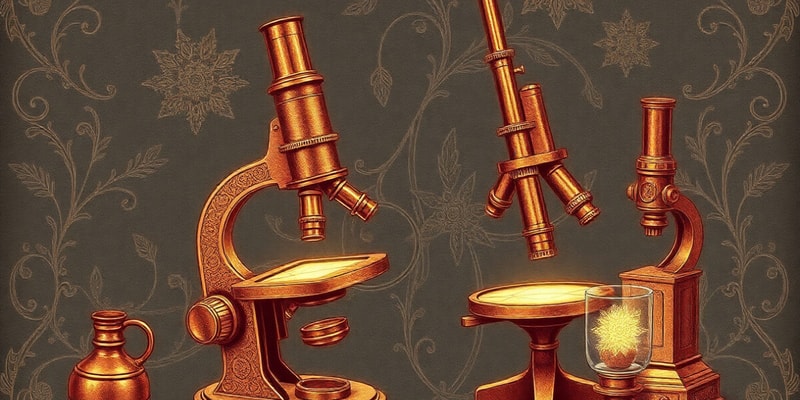Podcast
Questions and Answers
Which type of microscope is primarily used to observe stained preparations?
Which type of microscope is primarily used to observe stained preparations?
What is the main feature of a dark-field microscope?
What is the main feature of a dark-field microscope?
Which microscope is beneficial for examining live unstained organisms?
Which microscope is beneficial for examining live unstained organisms?
What is the primary function of fluorochromes in fluorescence microscopy?
What is the primary function of fluorochromes in fluorescence microscopy?
Signup and view all the answers
What distinguishes a scanning electron microscope (SEM) from a transmission electron microscope (TEM)?
What distinguishes a scanning electron microscope (SEM) from a transmission electron microscope (TEM)?
Signup and view all the answers
What is the primary function of a microscope?
What is the primary function of a microscope?
Signup and view all the answers
Which part of the microscope is used for adjusting light intensity?
Which part of the microscope is used for adjusting light intensity?
Signup and view all the answers
Who is recognized as one of the pioneers of microscopy in the late 17th century?
Who is recognized as one of the pioneers of microscopy in the late 17th century?
Signup and view all the answers
What characteristic distinguishes a binocular microscope from a monocular microscope?
What characteristic distinguishes a binocular microscope from a monocular microscope?
Signup and view all the answers
What does the fine adjustment knob of a microscope do?
What does the fine adjustment knob of a microscope do?
Signup and view all the answers
In which type of microscope does a beam of light help to view specimens?
In which type of microscope does a beam of light help to view specimens?
Signup and view all the answers
Which part of the microscope connects the eyepiece to the objective lenses?
Which part of the microscope connects the eyepiece to the objective lenses?
Signup and view all the answers
What advantage does the presence of a condenser lens provide in microscopy?
What advantage does the presence of a condenser lens provide in microscopy?
Signup and view all the answers
Study Notes
Introduction to Microscope
- A microscope is essential for magnifying small objects or details invisible to the naked eye.
- Key uses include observing bacteria, fungi, parasites, and host cells in both stained and unstained preparations.
- The origins of magnifying lenses trace back to 1021 CE with Ibn al-Haytham's "Book of Optics."
- Antony Van Leeuwenhoek, a Dutch scientist, was among the pioneers of microscopy in the late 17th century, creating and using a true microscope.
Parts of a Compound Microscope
- Eyepiece (Ocular Lens): Located at the top, magnifies objects typically at 10X or 15X.
- Tube: Connects the eyepiece to the objective lenses.
- Objective Lenses: Usually comprises 3 to 4 lenses with magnifications of 4X, 10X, 40X, and 100X.
- Diaphragm: Regulates the amount of light that reaches the specimen.
- Coarse Adjustment Knob: Used to bring the specimen into focus at low power.
- Fine Adjustment Knob: For precise focusing at higher magnifications.
- Arm: Supports the body tube of the microscope.
- Stage: The flat platform for holding slides during observation.
- Stage Clips: Secures slides in place on the stage.
- Condenser: Focuses light on the specimen, enhancing image sharpness.
- Base: Offers stable support for the entire microscope.
- Power Switch: Turns the illumination system on or off.
Types of Microscopes
- Compound Light Microscope: Utilizes light beams to view specimens; monocular has one eyepiece, binocular has two.
Light Microscopes
-
Bright-field Microscope:
- Commonly used; provides a brightly lit field of view for observing stained specimens.
-
Dark-field Microscope:
- Utilizes a special condenser for dark backgrounds, highlighting illuminated specimens without staining.
-
Phase-contrast Microscope:
- Specialized for viewing live unstained organisms using unique condensers and objectives, ideal for biological materials.
-
Fluorescence Microscope:
- Specimens are stained with fluorochromes; high-energy light excites molecules for detailed observations used in living cells and tissues.
Electron Microscopes
- Operate using electron beams instead of light, achieving magnifications of about 100,000x or higher due to shorter wavelengths.
-
Types of Electron Microscopes:
- Transmission Electron Microscope (TEM): Provides detailed images of the internal structure of specimens.
- Scanning Electron Microscope (SEM): Offers detailed surface views of specimens.
Studying That Suits You
Use AI to generate personalized quizzes and flashcards to suit your learning preferences.
Description
This quiz explores the various types of microscopes, their parts, and uses within the context of microbiology. It provides an overview of how microscopes enhance our ability to view and study microorganisms like bacteria, fungi, and parasites. Designed for first-stage students at Kirkuk University's Microbiology Department.





